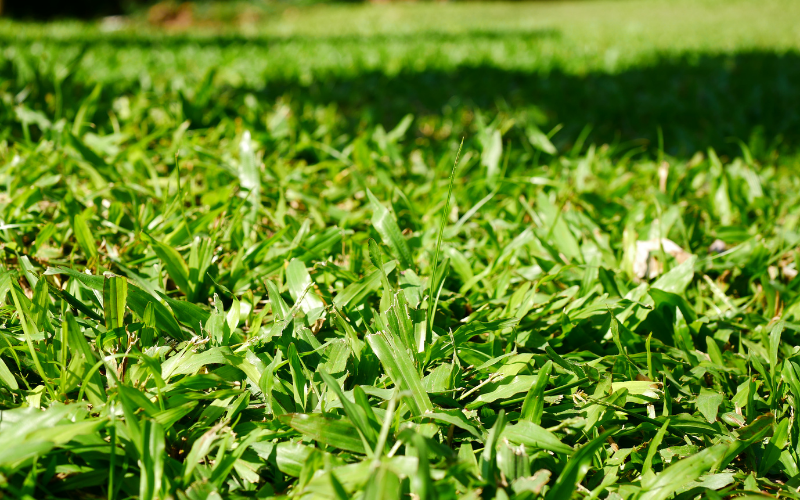Lawn stripes, making them and paying attention to them, can provide several benefits to your lawn beyond improving its appearance. Lawn stripes encourage you to mow your lawn in a way that encourages better, faster growth and helps avoid ruts and other distortions to the ground underneath your lawn. However, striping Bermuda grass can be more challenging than striping nearly any other type of lawn grass.
Can You Stripe Bermuda Grass?
Yes, you can stripe bermuda grass. Bermuda grass does not, however, stripe as readily as many other grass types. Due to its broad, blunt blades and low, tilted growth habit, bermudagrass is a challenge to stripe.
How to Stripe Bermuda Grass (My Tips)
Striping a bermuda grass lawn is a challenge. You need the right strategy, tools, and attitude to achieve strong, long-lasting, high-contrast stripes. The following tips should help you get the look you want without harming your lawn.
Ensure Your Lawn is Healthy
While bermuda grass is difficult to stripe in the best of conditions, attempting to do so while your grass is thinning is asking too much. Before you begin. Take a walk around your yard and note any thinning patches, bare spots, or uneven terrain. The grass should be thick and even over at least 80% of the yard, or the stripes will not take. Holes should be filled in and the turf replaced. If the lawn is too shaded or uneven, mixing in or overseeding a secondary grass type may be needed to achieve the best stripes.
Check Your Tools
To stripe your lawn while it is being mown, you will need either a weighted mower, reel mower, roller attachment, groomer, or a combination of these tools. With bermudagrass, a standard, weighted riding mower or a push mower with a roller attachment should suffice. A groomer, either homemade or purchased commercially, is also essential in most cases if you want long-lasting bermuda grass lawn stripes.
Choose the Right Mowing Height
The right mowing height for Bermuda grass is typically 1.5” to 2” most of the year, with 2.5” to 3” being an acceptable choice for the hottest summer months in zones 7b and above.
Take Your Time
Striping a lawn is all about convincing the grass to lay over and grow in a certain way. Grass growth patterns take time to change. With each pass, you’re teaching the grass to be more adaptable and discouraging it from being stubborn about the way it lays. If you’ve ever tried to part your hair in a new way, this is a very similar process and it will take about the same amount of time.
The longer you stripe your grass, in any direction, the longer those stripes and likely to last. At first, your lawn may lose its stripes in as little as a day. I know how discouraging that can be. However, if you keep at it you should start to see the stripes last longer with each mowing session. Bermuda grass stripes, if done consistently on a healthy lawn, should last 4 days or more.
Make a Plan
All you need to do to make a plan is to decide which direction you will be mowing your lawn to stripe it. Many people choose to start striping using an East-to-West and the West-to-East set of stripes, as this makes it easy to remember and adapt the next time they need to mow. Before you begin any set of stripes, mow around the perimeter of your lawn, unless there is a complete walkway around it, or the section you are mowing.
Sharpen Your Lawnmower Blades
Sharp blades will help you create distinct stripes on any grass type, not just Bermuda. However, with how difficult Bermuda grass can be to stripe, sharp blades and just the right height can make all the difference.
Mow Your Lawn, Following Your Plan
Mow any “access areas” or a single strip around the largest section of your lawn. This will give you a good starting and stopping place between stripes. Mow your first stripe straight from one side of the lawn to the other, then turn your mower around on the path you have already mown and go straight back down the other way. Keep your lines as straight as you can.
Finish Up With Any Grooming Treatments
Groomers are large brushes that make a big difference when you need to convince a stubborn grass type like Bermuda to go in a new direction. These can be affixed to the back of a tractor or mower, or they may be a standalone tool that is used to go over any stripes that have already been mown into a lawn. With a Bermudagrass lawn, a groomer is often a good purchase as a mower or even mower/roller combo may not leave lasting stripes.
Take Notes and Adjust Your Plan as Needed
Every lawn is different. Some lawns will have just the right conditions to stripe well right away in the first direction you try. The more shade you have on your lawn, for example, the harder it generally is to stripe the grass. Further, the thicker your lawn is, the shorter you may need to mow it for prominent stripes to show up. Taking notes is how you learn what your lawn needs, over time, to be its best.
Remember to Avoid Ruts
With Bermuda grass and other broad-bladed grass types, you can mow the stripes in the same direction for a few weeks at a time before you need to change things up. If you continue to mow your lawn the same way each time, you may end up compacting the soil in certain spots and creating dents or “ruts” in your yard. By rotating your stripes 45 degrees every few weeks, it should be possible to avoid this problem.
How Topography Can Prevent Lawn Stripes with Bermuda Grass
Now that you know how to stripe Bermuda grass, it’s important to point out that attempting to stripe a Bermuda grass lawn that’s uneven, with hills and valleys or that is in more shade than sun, is close to impossible.
Topography is key when you’re looking to stripe a lawn. While it matters less with cool-season grasses, warm-season grasses, especially those that are stolon-type or that have broad blades, will not stripe if they are in shaded areas. Even if you do manage to groom them into the right formation, it won’t hold more than a day or two. If this is the situation you are in, it may be worth considering the option I’m going to talk about below.
Overseeding – An Alternate Strategy for Bermuda Lawn Stripes
Bermuda grass is one of the toughest grass types to stripe. Even if you invest in just the right mower and groomer combination, it will take a month of consistent use to get things to start shaping up. Then you need to change things up every few months to keep your lawn healthy, starting the process all over.
If your yard is uneven, or you don’t like the time and money investment you need to make to keep bermuda grass stripes looking sharp, there is an alternative. Overseeding the lawn with rye during the summer is a strategy many homeowners and even sports fields use.
All you need to do is overseed with ryegrass as you usually would, and within a month you will have a lawn that will give much more pronounced stripes with far less effort, using the same strategy listed above. This strategy works exceptionally well for uneven lawns or in places where the Bermuda grass itself isn’t as thick as it needs to be to stripe well.



Leave a Reply